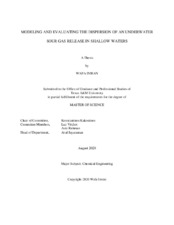| dc.description.abstract | In the ocean, at offshore production facilities, subsea gas releases can occur from the rupture of subsea pipelines, failure in flow lines, gas export lines and subsea equipment. There have been many subsea gas release incidents in the oil and gas industry, where natural gas is released. An increasing numbers of sour gas reserves are being found, with a high number within the Middle East. The release of sour gas can cause toxic exposure, fire and explosion issues, leading to major environmental and safety impacts. Therefore it is important to understand the phenomena of subsea gas release as it will aid in controlling and quantifying the risks associated with it. From literature it is found that CFD models are developed to quantify the severity of risks associated with subsea releases of natural gas. The usage of CFD models is expensive and time consuming hence in this project a nomograph was generated in order to extract data for risk assessment in an easier and more efficient way. In order to do so a transient, Eulerian-Eulerian CFD model was developed to model the release of sour gas in shallow waters to obtain simulation results to construct the nomograph. The model was validated against Engebretsen’s 1997 experiment. The simulation results showed excellent agreement with the experimental data. The validated model was expanded to predict the behavior of the bubble plume for several scenarios for Qatar’s industry, for release depths between 25 and 100 m, release mass flow rates between 20 and 80 kg/s, release hole diameters between 0.05 and 0.25 m and sour gases with H2S compositions of 11 and 22 % by mass. A sensitivity analysis was performed that indicated high concentrations of CH4 and H2S on the surface, suggesting that dispersion modeling be carried out to determine what offshore facilities are within the vicinity of flammable and toxic clouds. The results obtained from the expanded CFD model include surface mass flux, rise time and surface gas concentrations. Using the results a nomograph was generated in order to extract data for risk assessment. | en |


